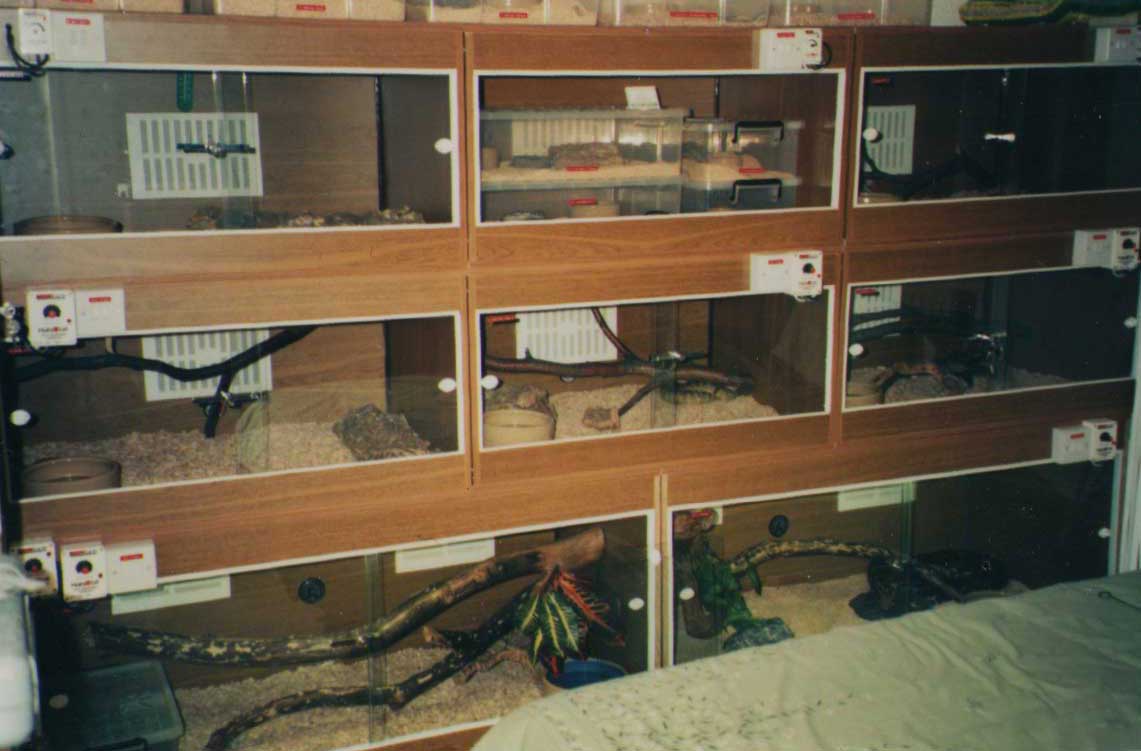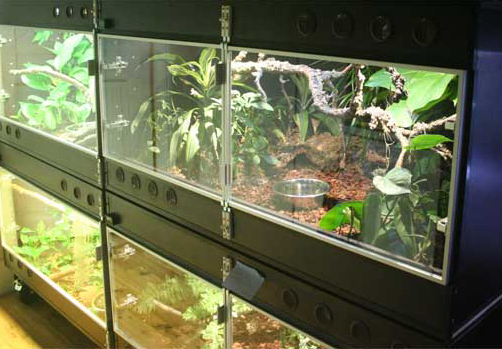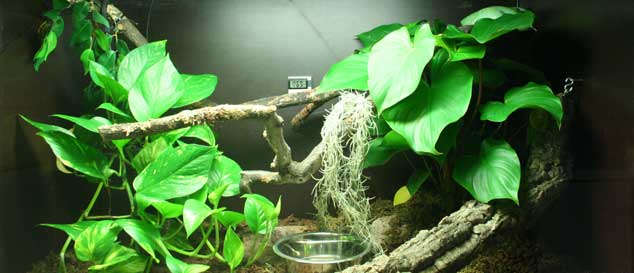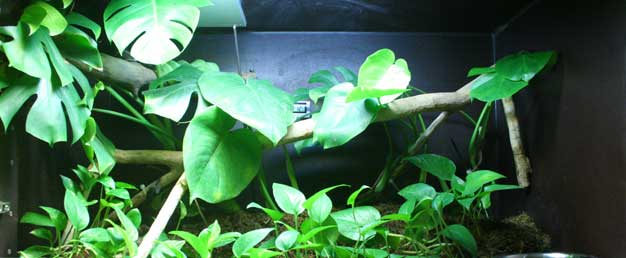
On this page you can find information about how I set up my terrariums and my approach to general care and maintenance.
When I first started keeping snakes there wasn't the choice of ready made terrariums that there is today and so I built my own terrariums from melamine with sliding glass doors. The melamine was good at holding temperature and if you took care not to damage the surface and sealed all the edges with silicone they held up very well to moisture too. The one big drawback with melamine was the weight of the finished terrariums.
|
|---|
Here is an
image taken in
1994 of part of my set up in England using melamine and sliding glass door terrariums.
All my terrariums in Sweden are built using Form-Ply (an epoxy coated plywood) and hinged glass doors.
Form-Ply has good thermal qualities, withstands moisture very well and is lightweight.
I like the fact that with a hinged door the whole front of the terrarium can be open rather than half at a time that you get with sliding glass doors.
Below is an image of part of my current set up in Sweden.
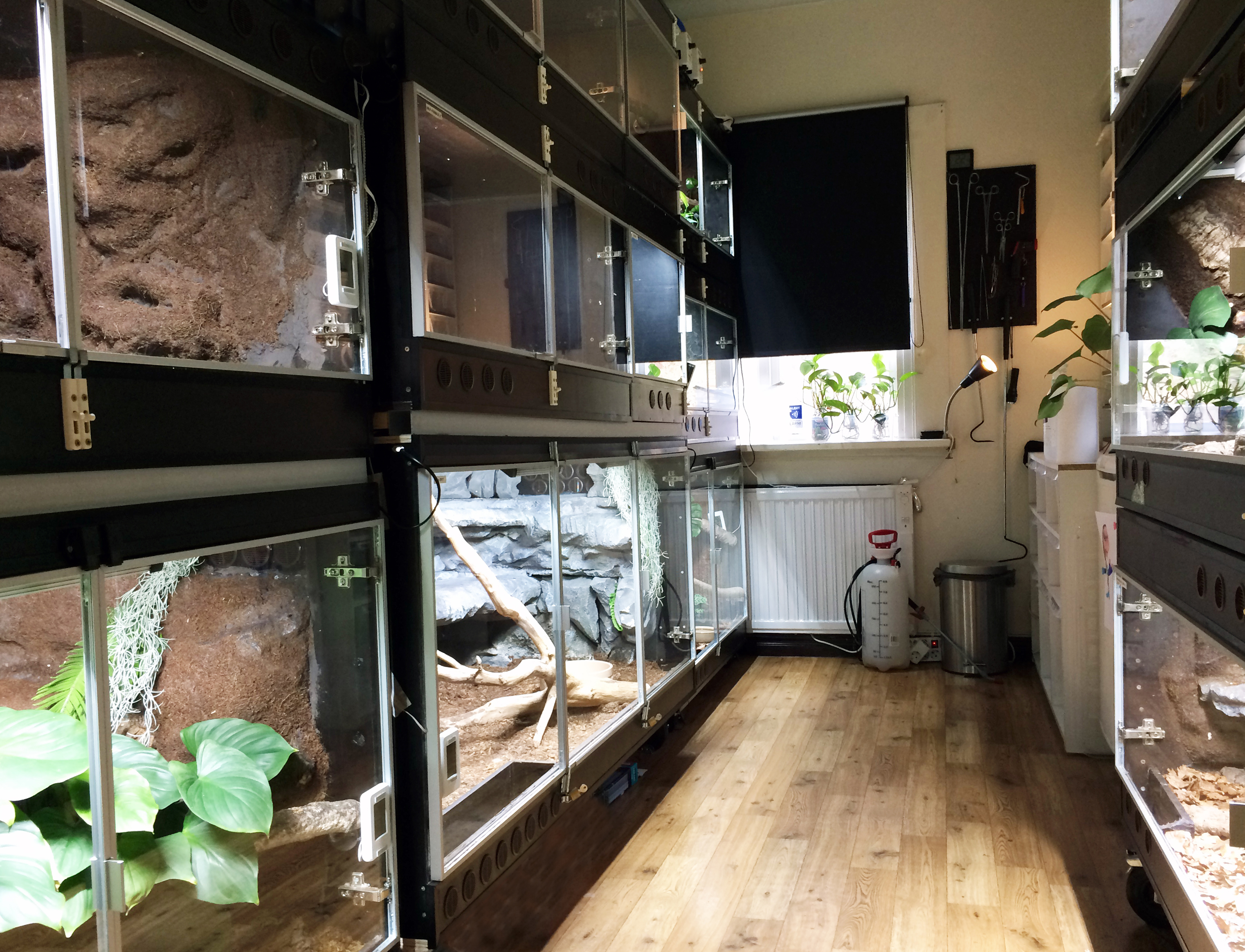 |
All my terrariums are heated using ceiling mounted heat panels that are controlled by Pulse Proportional, Day/Night Thermostats.
Daylight lighting on all my terrariums is Arcadia jungle dawn full spectrum LED's.
I have also fitted low intensity red LED strip lights that can be dimmed to a very low level and I use these at night when feeding and for occasional night time viewing. At all other times these red lights are off.
In keeping with current thinking within herpetoculture, I am planning on adding and experimenting with UVB lighting in the near future with my collection.
All my terrariums are on a 12hr on 12hr off light cycle. The temperature settings are dependant on species. I provide a year round night time temperature drop for all species. The amount of night drop depends on the time of year.
|
Here is another image of my current set up in Sweden. |
Any young that I produce are kept in a rack system that has back heat supplied by heat mats covering the back wall of the rack. They are again controlled by Pulse Proportional thermostats and have a general temperature of 29.5C at the rear of the tubs and 27.5C at the front with no night drop.
Homemade baby racks |
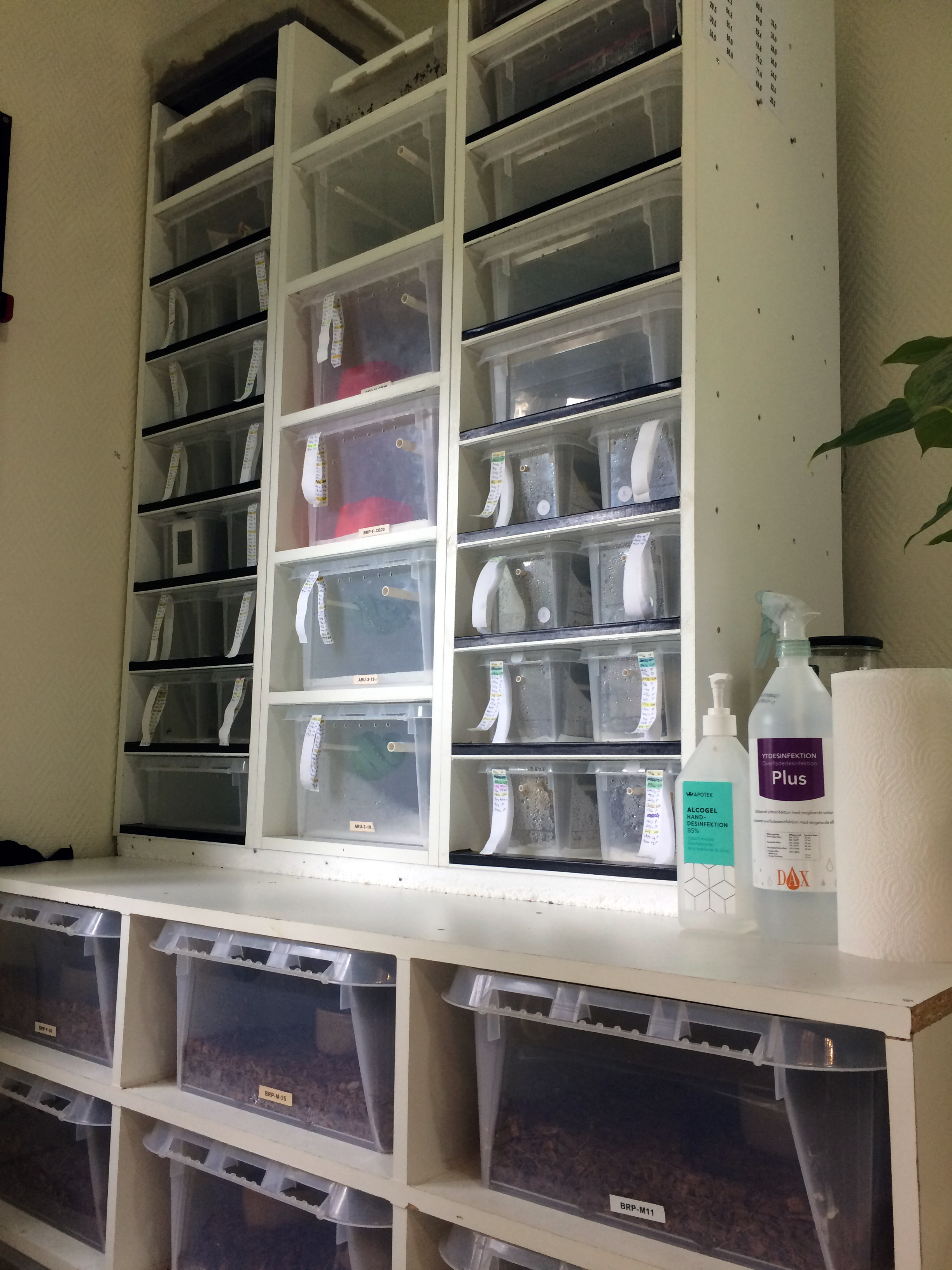 |
The tubs are kept quite basic to allow for easy cleaning and generally have paper towels for substrate with plastic perches, plastic hide boxes with an entrance hole cut in the top, damp sphagnum moss hide box and small glass water bowls.
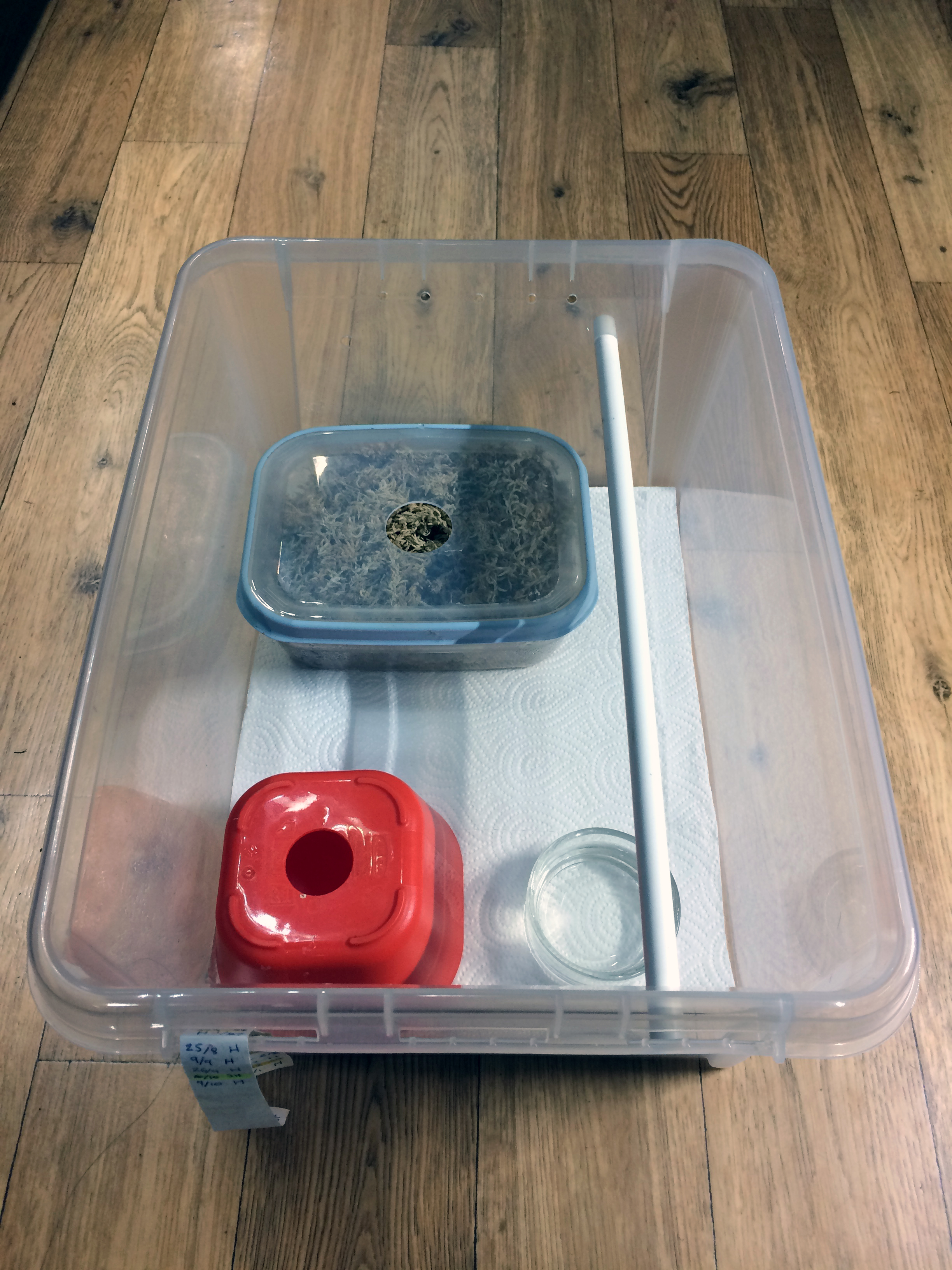 |
Basic tub set up for baby terrestrial python, with damp sphagnum filled hide box, plastic hide box, paper towel substrate, water bowl and plastic perch. |
I change all my animals water at least a couple of times a week and disinfect all water bowls every two weeks. To disinfect the water bowls, feeding tongs, hooks and to clean tubs/terrariums when needed I use a product called DAX Plus.
I also make an effort to clean water bowls and offer fresh water on feeding days as I have noticed many snakes in my collection will often drink quite heavily immediately after feeding.
With feeding I am a firm believer in the "less is more" approach and think it is better in the long term to grow animals slowly, rather than pushing to gain bulk and body weight as quickly as possible.
Aside from avoiding obesity and all the health issues that can arise from over feeding, I believe there may be another reason to feed less often.
Research into python digestion has shown the intestines and liver grow in size by up to three times their original size after prey is swallowed. These organs begin to shrink in size again after the prey passes through the intestines and return to normal size within the next eight days or so after the prey has been digested.
Snakes have evolved the ability to develop their digestive organs into extremely efficient functional units within a very short time and return them to their original state when they have done their job (Starck, Beese 2001)
If pythons in captivity are fed on a regular schedule with no irregularity or fasting breaks and therefore never allowing the digestive organs to achieve "normal" size and remain at this normal size for any period of time, then are we denying these animals a natural and possibly necessary bodily function that may aid longevity and overall health?
I build display style terrariums for my collection and find when observing my adult animals at night under low intensity red light, all of my collection will make full use of the space they are given.
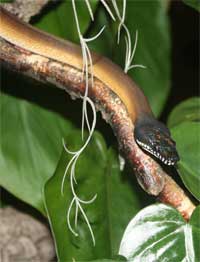 |
Leiopython albertisii (White Lipped Pythons) are very active snakes and will use the whole terrarium space given. |
The two images below show adult
|
|---|
For my arboreal species I aim to provide perches with plant cover above them and I find that the daily resting places of these animals vary quite frequently. Rather than always sitting on the highest perch as is commonly reported in many arboreal species, most of my arboreal snakes choose to sit in areas that have leaf cover above them.
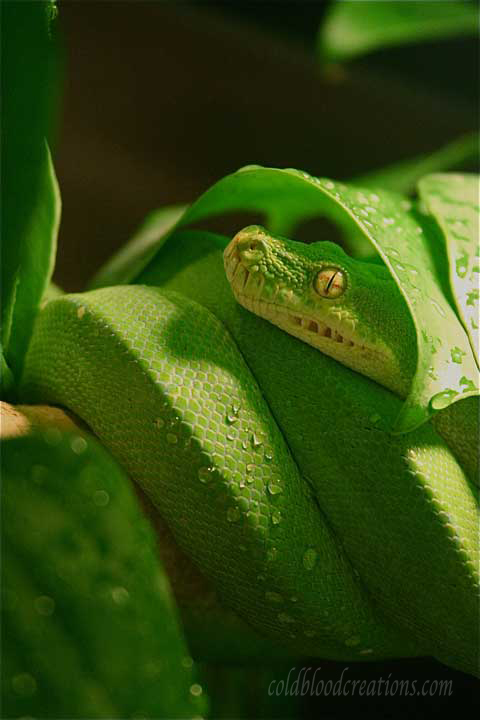 |
This male Morelia viridis (Green tree python) uses three or four perch positions in his terrarium but almost always chooses areas of perch that are under leaf cover.
Something that I have been trying since 2013 is adding backgrounds to my terrariums. I have tried to add to the terrariums usable space by incorporating shelves and hides in the background design at both the warm and cool sides of the terrarium, whilst giving the terrariums a more natural look. One big advantage that I have found with using a background is how easy it is to quickly increase humidity, as the background gives a much larger surface area to spray when needed.
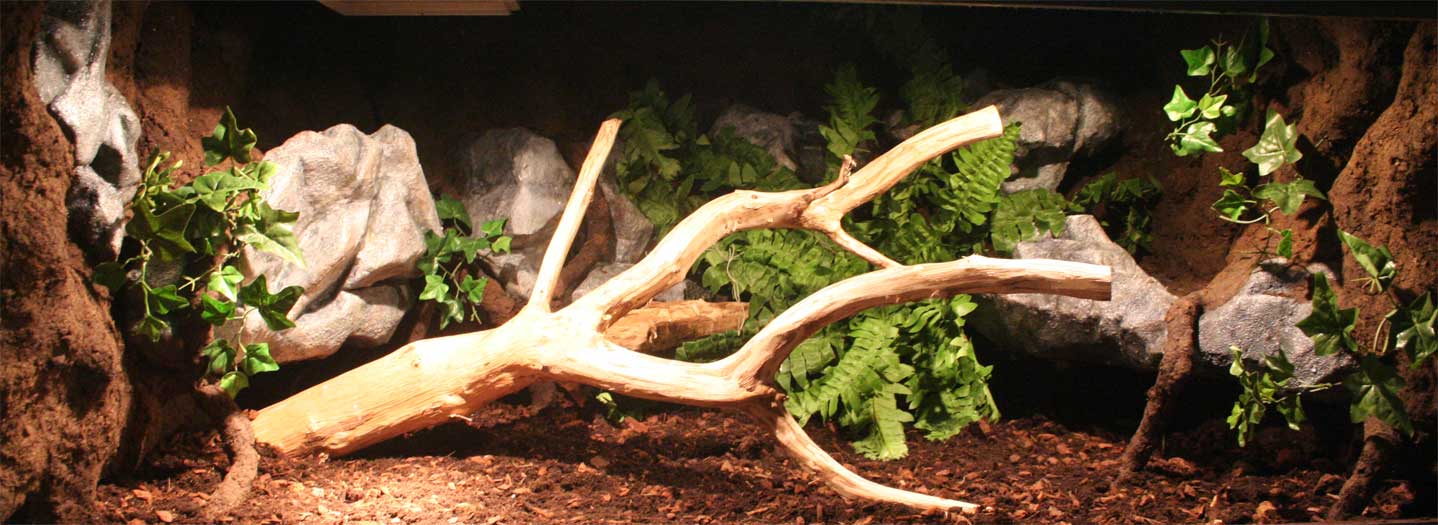
Enclosure with background.
To see how it was made click here.
I've also started to use a blended substrate of peat moss, sphagnum moss and bark chip. This allows planting directly into the substrate rather than keeping the plants in pots. After trying this in a couple of terrariums I changed nearly all my terrariums from bark chip substrate to this blended substrate.

Another scaped enclosure
These deeper bio active type substrates keep humidity levels up whilst staying dry on the surface compared to the bark chip. The substrate can be quite heavily watered and will slowly release the moisture over several days from the bottom up whilst leaving the surface relatively dry. This keeps general humidity more stable and avoids the need for daily spraying to raise humidity levels.
It has shown good results with better sheds, especially with Leiopython albertisi and Bothrochilus boa. Very thin skinned python species that often have trouble sloughing in one piece. I have also noticedmore active behaviour generally in my snakes since changing substrate.
Cultures of springtails and small isopods are added to break down some of the waste from the snakes and turn it into a more bio active type set up. I have found this has worked very well although I do remove urates and faecal matter from the terrarium whenever spotted. Another important consideration is to add a layer of leaf litter on top of the substrate. This gives the springtails and arthropods damp microclimates within the terrarium as well as providing a food source if there is little snake waste to feed on. When working well this method also greatly reduces any odour from the terrariums and the snake room in general.
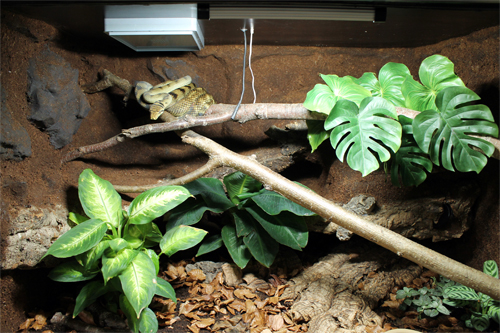
Simalia amethistina (Northern scrub python) enclosure.
For more information about how I build my terrariums please click HERE
For more information about backgrounds, substrate and decor please clickHERE

